CCNA – Operations 1
Here you will find answers to Operations Questions (Part 1)
Question 1:
What are two reasons that a network administrator would use access lists? (Choose two.)
A. to control vty access into a router
B. to control broadcast traffic through a router
C. to filter traffic as it passes through a router
D. to filter traffic that originates from the router
E. to replace passwords as a line of defense against security incursions
Answers: A C
Question 2:
A single 802.11g access point has been configured and installed in the center of a square office. A few wireless users are experiencing slow performance and drops while most users are operating at peak efficiency. What are three likely causes of this problem? (Choose three.)
A. mismatched TKIP encryption
B. null SSID
C. cordless phones
D. mismatched SSID
E. metal file cabinets
F. antenna type or direction
Answers: C E F
Question 3:
Refer to the exhibit. How many broadcast domains exist in the exhibited topology?
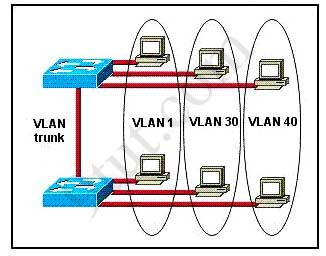
A. one
B. two
C. three
D. four
E. five
F. six
Answer: C
Question 4:
Which type of attack is characterized by a flood of packets that are requesting a TCP connection to a server?
A. denial of service
B. brute force
C. reconnaissance
D. Trojan horse
Answer: A
Question 5:
Refer to the exhibit.
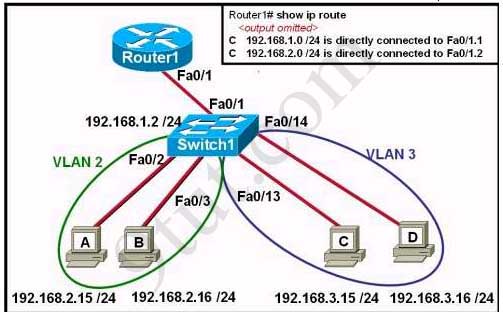
The network administrator has created a new VLAN on Switch1 and added host C and host D. The administrator has properly configured switch interfaces FastEthernet0/13 through FastEthernet0/24 to be members of the new VLAN. However, after the network administrator completed the configuration, host A could communicate with host B, but host A could not communicate with host C or host D. Which commands are required to resolve this problem?
A. Router(config)# interface fastethernet 0/1.3
Router(config-if)# encapsulation dot1q 3
Router(config-if)# ip address 192.168.3.1 255.255.255.0
B. Router(config)# router rip
Router(config-router)# network 192.168.1.0
Router(config-router)# network 192.168.2.0
Router(config-router)# network 192.168.3.0
C. Switch1# vlan database
Switch1(vlan)# vtp v2-mode
Switch1(vlan)# vtp domain cisco
Switch1(vlan)# vtp server
D. Switch1(config)# interface fastethernet 0/1
Switch1(config-if)# switchport mode trunk
Switch1(config-if)# switchport trunk encapsulation isl
Answer: A
Explanation:
Communication between host A and host B on the same VLAN does not need a router but communication between host A and host C (or host D) need a layer 3 device, in this case Router1, which is called a “router on a stick”. From the output of Router1, we notice that there is not any route to the new network 192.168.3.0/24 which host C and host D belong to. Therefore, we need to configure a subinterface for this network.
Question 6:
Refer to the exhibit. What is the most efficient summarization that R1 can use to advertise its networks to R2?
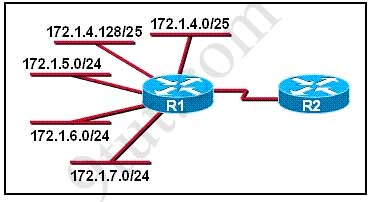
A. 172.1.0.0/22
B. 172.1.0.0/21
C. 172.1.4.0/22
D. 172.1.4.0/24
172.1.5.0/24
172.1.6.0/24
172.1.7.0/24
E. 172.1.4.0/25
172.1.4.128/25
172.1.5.0/24
172.1.6.0/24
172.1.7.0/24
Answer: C
Explanation:
Network 172.1.4.0/25 and network 172.1.4.128/25 can be grouped to a single network 172.1.4.0/24
Network 172.1.4.0/24 + Network 172.1.5.0/24 + Network 172.1.6.0/24 + Network 172.1.7.0/24 can be grouped to a single network 172.1.4.0/22 because we have all 4 subnetworks so we can move left 2 bits (22=4)
Question 7:
Which spread spectrum technology does the 802.11b standard define for operation?
A. IR
B. DSSS
C. FHSS
D. DSSS and FHSS
E. IR, FHSS, and DSSS
Answer: B
Question 8:
A network interface port has collision detection and carrier sensing enabled on a shared twisted pair network. From this statement, what is known about the network interface port?
A. This is a 10 Mb/s switch port.
B. This is a 100 Mb/s switch port.
C. This is an Ethernet port operating at half duplex.
D. This is an Ethernet port operating at full duplex.
E. This is a port on a network interface card in a PC.
Answer: C
Explanation:
Modern Ethernet networks built with switches and full-duplex connections no longer utilize CSMA/CD. CSMA/CD is only used in obsolete shared media Ethernet (which uses repeater or hub).
Question 9:
Refer to the topology and router configuration shown in the graphic. A host on the LAN is accessing an FTP server across the Internet. Which of the following addresses could appear as a source address for the packets forwarded by the router to the destination server?
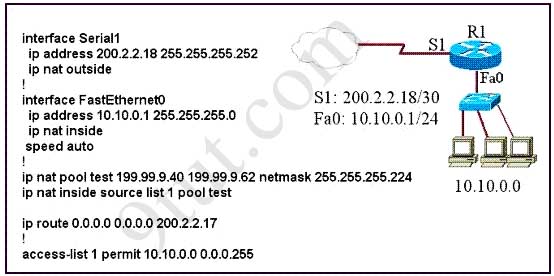
A. 10.10.0.1
B. 10.10.0.2
C. 199.99.9.33
D. 199.99.9.57
E. 200.2.2.17
F. 200.2.2.18
Answer: D
Question 10:
Which routing protocol by default uses bandwidth and delay as metrics?
A. RIP
B. BGP
C. OSPF
D. EIGRP
Answer: D
Question 11:
Refer to the exhibit. The networks connected to router R2 have been summarized as a 192.168.176.0/21 route and sent to R1. Which two packet destination addresses will R1 forward to R2? (Choose two)
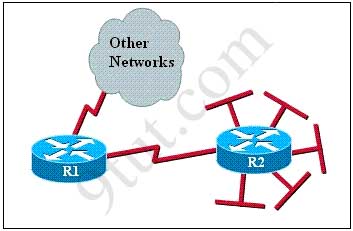
A. 192.168.194.160
B. 192.168.183.41
C. 192.168.159.2
D. 192.168.183.255
E. 192.168.179.4
F. 192.168.184.45
Answer: B E
Explanation:
From the subnet mask of /21, we can specify the network address and broadcast address of this subnetwork:
Increment: 8 of the third octet(/21 = 255.255.248.0 or 1111 1111.1111 1111. 1111 1000.0000 0000)
Network address: 192.168.176.0
Broadcast address: 192.168.183.255 (183 = 176 + 8 – 1)
Therefore all the destination addresses in this range will be forwarded to R2 -> B and E lie in this range and their packages will be forwarded to R2. Please notice that D is an incorrect answer because it is a broadcast address and R1 will drop its packages.
Question 12:
Refer to the exhibit. Which switch provides the spanning-tree designated port role for the network segment that services the printers?
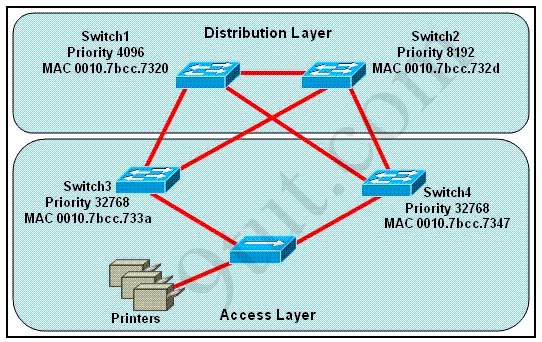
A. Switch1
B. Switch2
C. Switch3
D. Switch4
Answer: C



Can U explain question 9:
Why does S1 has ip address 200.2.2.18, whereas the access-list pool is 199.99.9.40….
Is it wrong??
The purpose of the command “ip nat pool test 199.99.9.40 199.99.9.62 …” is to translate all the source addresses that pass R1 router, which means a source address from the 10.0.0.0/24 network to an address from this pool. It doesn’t affect the address of S1, that means S1 can have an address outside this pool
Q12
sw3 and sw4 are nearest to printer so ans must be between two
both switch have the same cost so lowest bridge id wil be next criteria .here is condition lowest priority will win the designated port
but both of them have same priority lowest mac address is the last choice & it can not be same………everyone know
so sw3 port will become designated port and ans is (c)
Hi 9tut Thank u very much for the help u r giving and i hope god will reward u back
can u explain q 6 please
and in q 11 y is answer d wrong ?
thanx friend
Question 6:
Network 172.1.4.0/25 and network 172.1.4.128/25 can be grouped to a single network 172.1.4.0/24
Network 172.1.4.0/24 + Network 172.1.5.0/24 + Network 172.1.6.0/24 + Network 172.1.7.0/24 can be grouped to a single network 172.1.4.0/22 because we have all 4 subnetworks so we can move left 2 bits (2^2=4)
Question 11: D is an incorrect answer because it is a broadcast address and R1 will drop its packages
q9. You have host on the LAN which is network 10.10.0.0/24. This is a private IP which cannot be set out to the internet. Therefore the router uses NAT which replaces the private IP with a public IP from the NAT pool before sending it the the FTP server. The NAT pool addresses are 199.99.9.40 through 199.99.9.62. The only answer that has an IP in that range is D (199.99.9.57). Basically the correct answer is any IP in the NAT pool range. So on your exam the answer could be different from .57. Better to understand rather than just memorizing the correct answer.
q6. The best way to explain this is to look at the bits. The first 2 octals 172.1 are the same for all 5 networks so they are not important. The third is where you need to look.
.4 is 00000100
.5 is 00000101
.6 is 00000110
.7 is 00000111
Now you can see that starting from the left the next 6 bits (000001) are the same for all the networks. It’s when you get to the 7th bit things no longer match. Therefore you can sum the networks (match all the bits) up to the 7th bit in the 3rd octal. That’s 8+8+6=22. So the correct answer is 172.1.4.0/22
Q6
Refer to the exhibit. What is the most efficient summarization that R1 can use to advertise its networks to R2?
A. 172.1.0.0/22
B. 172.1.0.0/21—–I get this answer.
C. 172.1.4.0/22
Correct: C ——why?
172.1.4.0/25 10101100.00000001.00000 100.00000000
172.1.4.128/25 10101100.00000001.00000 100.10000000
172.1.5.0/24 10101100.00000001.00000 101.00000000
172.1.6.0/24 10101100.00000001.00000 110.00000000
172.1.7.0/24 10101100.00000001.00000 111 .00000000
Mask:11111111.11111111.11111 000.00000000
Please explain Q3.
i read that there are only 1 broadcast domain in a switch however it increases collision domains.
To Asad: Yes, if there was only one VLAN then the answer would be 1 but we have 3 VLANs, each creates a broadcast domain so the answer will be 3
i dont understand question 5 pls explain thank you
About Q1
Can anyone explain why option D is incorrect
What are two reasons that a network administrator would use access lists? (Choose two.)
D. to filter traffic that originates from the router
To aNnie: I updated the page with the explanation you need, aNnie!
To Hybrid: Any access lists applied to interfaces will not impact traffic that originates from the router where the access lists are defined. For example, configuring an outbound access list that denies telnet traffic will not deny a telnet session initiated from the router from leaving that interface
I got this question in my exam and I still don’t know which is the answer.
( The question that I’m gonna write is what I remember?
Q. There is a certain topology were routers are used, which routing protocol will the routers learn and used?
a. Rip v2 metric 4
2. EIGRP 2456223
3. OSPF 110
4. All three
5. Just EIGRP & OSPF
6. EIGRP and RIp v2 metric 4
I got confused because their metrics were not the default in that case I have chosen eigrp. But in this case the exam put it some metrics.
I chose EIGRP but I really don’t kno the answer.
@hrc8312
I think answer to your question would be 3.OSPF since it has default admin route. It would have been EIGRP if the metric was 90.
I am not 100% sure though.
Anyone else have any idea on this?
i think the answer for this question is eigrp bec. eigrp calculate its metric according to bandwidth & delay & this no. is the no. calculated by the equation of calculating the metric of eigrp & by default the router will choose the lowest administrative distance not the lower metric so it will choose eigrp
9tut,
please help me,i have problem comparing/rating mac addresses with alphabet so as to know which switch becomes root bridge and further more the port that will be in blocking state.please help me my exam date is so close.
for example the 733a in q.12
a = 10; b=11; c=12;d=13;e=14;f=15. Therefore 9< a < b < c < d < e < f. For example 9B-B0-D0-86-BB-F7 < AB-B0-D0-86-BB-F7
hi can any one explain for me this question, please i need full explanation as my exam date getting very close, and how did you find the answer.
The internet networks connected to router1 have been summarized for router2 as 192.1.144.0/20 which of the following packet destination addresses will router2 forward to router1 according to this summery?
A. 192.1.159.2
B. 192.1.160.11
C. 192.1.138.41
D. 192.1.151.254
E. 192.1.143.145
F. 192.1.1.144
adil ur answer is a,d because the netmask which u have given is /20 and its range is 16 i.e.255.255.240.0 (network bits will be 4 in 3rd octet i.e. 11110000 and the valu of 1111 is 16)
therefore u add 16 in 144 it will be 160 and the address which will go will be 192.1.160.11
and 192.1.143.145.
Q11 -
Increment: 8 of the third octet(/21 = 255.255.248.0 or 1111 1111.1111 1111. 1111 1000.0000 0000)
Network address: 192.168.176.0
Broadcast address: 192.168.183.255 (183 = 176 + 8 – 1)
why Bcast address = 192.169.183.255, not 192.168.183.0 or 192.168.184.0?
confustion about 3rd octet mask/increment/address.
Any help? thanks in advance.
Hi NewHere,
For Q11 – First we need to understand why we are adding 8 to 176.
/ 21 or 255.255.248.0 or 1111 1111.1111 1111. 1111 1000.0000 0000 shows that there are 11 bits for hosts i.e. 2 raised to 11 = 2048
So in the last octet we can get a max 256 addresses 2048 / 256 = 8.
so it will be as follows : 192.168.176.0 — 192.168.176.255 (256 )
192.168.177.0 — 192.168.177.255 (256)
192.168.178.0 — 192.168.177.255 (256)
192.168.179.0 — 192.168.177.255 (256)
192.168.180.0 — 192.168.180.255 (256)
192.168.181.0 — 192.168.181.255 (256)
192.168.182.0 — 192.168.182.255 (256)
192.168.183.0 — 192.168.183.255 (256)
In the network of 2048 hosts 192.168.176.0 is the first so Network address and 192.168.183.255 the last so it is the Broadcast address.
Best Regards,
Jot this chart down when you get to your CCNA exam for easy subnetting!!
Bits borrowed 1 | 2 | 3 | 4 | 5 | 6 | 7 | 8 |
DDN .128 | .192 | .224 | .240 | .248 | .252 | .254 | .255
Block Size 128 | 64 | 32 | 16 | 8 | 4 | 2 | 1
prefix length /9 | /10 | /11 | /12 | /13 | /14 | /15 | /16
/17 /18 /19 /20 /21 /22 /23 /24
/25 /26 /27 /28 /29 /30 /31 /32
Sorry the formatting didn’t work out above- try to line up each column…
May be i am wrong and i am confused. I think answer to Q12 should be SW4 because 7347 < 733a. Please advice.
@rahul
7347 > 733a
as if you compare from the left 734 > 733, I hope you got what I mean to say, so the SW3 is the right answer for that.
Regards,
FAS
please could anyone explain question no. 6 and 9 answers in detail….
i dont understand how the answer has come….
please help me out…
thank you
Hi Max,
Question 6.
Refer to the exhibit. What is the most efficient summarization that R1 can use to advertise its networks to R2?
172.1.4.0
172.1.4.128
172.1.5.0
172.1.6.0
172.1.7.0
1. First two octets are the same, so we are interested in the 3rd octet.
We are looking for a point where all the bits no longer match. This will give us our new subnet mask and increment.
00000100
00000101
00000110
00000111
2. convert the matching bits to 1s and the nonmatching bits to 0s
11111100
our new subnet mask is 11111111.11111111.11111100.00000000 (22 bits) or 255.255.252.0 with an increment of 4
3. Write out subnets
subnet 1) 172.1.0.0
subnet 2) 172.1.4.0
subnet 3) 172.1.8.0
4. Question 6 aks for “most efficient” summarization that R1 can use for the following IP addresses:
172.1.4.0
172.1.4.128
172.1.5.0
172.1.6.0
172.1.7.0
So, to me, the answer is subnet 2 because the IP addresses fall into this subnet range
network = 172.1.4.0
broadcast = 172.1.7.255
The purpose of the command “ip nat pool test 199.99.9.40 199.99.9.62 netmask 255.255.55.224…” is to translate all the source addresses that pass R1 router, which means a source address from the 10.0.0.0/24 network to an address from this pool. It doesn’t affect the address of S1, that means S1 can have an address outside this pool
I think question 9 is asking about subnetting.
We are given the subnet mask so we can determing which octet we are working in and find our increment.
Subnet mask = 11111111.11111111.11111111.11100000 (/27)
Octet: 4
Increment = 32
2. Write our subnets
subnet 1 )199.99.9.0
subnet 2) 199.99.9.32
subnet 3) 199.99.9.64
….
….
3. Find subnet that our IP addresses fall into.
subnet 2
network = 199.99.9.32
first host IP = 199.99.9.33
last host ip = 199.99.9.62
broadcast = 199.9.9.63
4. Although both C & D are valid host IPs in this subnet, D is correct because 199.99.9.57 falls between 199.99.9.40 and 199.99.9.62 given in the command “ip nat pool test 199.99.9.40 199.99.9.62″.
A. 10.10.0.1
B. 10.10.0.2
C. 199.99.9.33
D. 199.99.9.57
E. 200.2.2.17
F. 200.2.2.18
Hello,
Question: How many subnets can be gained by subnetting 172.17.32.0/23 into a /27 mask, and how many usable host addresses will there be per subnet?
A. 8 subnets, 31 hosts
B. 8 subnets, 32 hosts
C. 16 subnets, 30 hosts
D. 16 subnets, 32 hosts
E. A Class B address can´t be subnetted into the fourth octet
Answer is C why? I can find 8 subnets but not 16.
We need to borrow 4 bits to increase subnet mask from /23 to /27
11111111.11111111.11111111.11100000
Increment is 16
2. Working in the 4th octet, write our subnets (give s us 16 subnets)
172.17.32.0
172.17.32.16
172.17.32.32
172.17.32.
…..
…..
…
172.17.32.256
3. Calculate number of hosts
number of host bits (0s) = 5
number of hosts = 2 to the power 5 = 32,minus 2 (for network and broadcast) = 30 hosts
Hi Ozzie!
256 divided by 16 equals 16
so 16 subnets .
No 8 subnet
@ OzzieT
Question: How many subnets can be gained by subnetting 172.17.32.0/23 into a /27 mask, and how many usable host addresses will there be per subnet?
A. 8 subnets, 31 hosts
B. 8 subnets, 32 hosts
C. 16 subnets, 30 hosts
D. 16 subnets, 32 hosts
E. A Class B address can´t be subnetted into the fourth octet
Answer is C why? I can find 8 subnets but not 16.
- – - – - – - – - – - – - – - – - – - – - – - – -
Answer is C… 16 subnets, 30 hosts
Here increment has got nothing to do. Just 2 basic things to remember:
1.
If h = total number of host bits (the Zero ones at right)
Then total IP address = 2^h
Total assignable addresses = (2^h)-2 (Minus 2 for network and broadcast ID)
2.
If n = total number of network bits (the 1s on the left)
Then total number of networks = 2^h
Initial mask is /23. By ADDING FOUR more bits you get /27. So how much you GAIN?
2^4 = 16 Subnets
Now because of the new /27 mask, host bits left = 32-27=5
Assignable Hosts = (2^5)-2 = 32-2 = 30
Cheers
@OzzieT
We need to borrow 4 bits to increase subnet mask from /23 to /27
11111111.11111111.11111111.11100000
Increment is 16
- – - – - – - – - – - -
OK. It can be done from the increment point of view as well. But /27 mask means 255.255.255.224 and 256-224=32.
Increment is 32 and not 16.
i got my exam yesterday and passed with 974. especial thanks for the 9tut. pass4sure & testinside dumps are still valid. sims are eigrp,vtp & access-list only the ip addresses are changed. in access-list the the pc also changed. again thanks for the 9tut and all of the contributors
if any one need help from me pls email to
hasy_001@yahoo.com
Took my exam today and passed 961. Like Hasy, I wish to thank 9tut and contributors, this is a great learning site. TestInside and Mashti valid, there were a few new questions but ideas the same. Sims were eigrp, access-list & vtp. The ip addresses were changed and the pc in access-list changed.
Question: How many subnets can be gained by subnetting 172.17.32.0/23 into a /27 mask came up, so thanks to all for explanation.
Q. There is a certain topology were routers are used, which routing protocol will the routers learn and used?
a. Rip v2 metric 4
2. EIGRP 2456223
3. OSPF 110
4. All three
5. Just EIGRP & OSPF
6. EIGRP and RIp v2 metric 4
———
Router will put EIGRP route because administrative distance (metric is no innvolved!) of EIGRP is the least one.
I don’t understand Question 8, where is difference between half duplex and full duplex come from?
Q12
In Pass4sure v17.14 the answer is Switch 1 but in vcem the answer is Switch 3…
Here the answer is Switch 3… So i will go for Switch 3…
to adil i found this answer at: http://www.sadikhov.com/forum/index.php?showtopic=163408
TESLA.COIL wrote:
192.1.144.0/20
We have /20 , that means there is a change in the 3rd octet. With /20 as subnetmask the increment has to be of 16 in the 3rd octet
>192.1.0.0 – 192.1.15.255
>192.1.16.0- 192.1.31.255
>192.1.32.0
.
.
.
.
.
192.1.128.0
192.1.144.0 – 192.1.159.255>>>>>>> This is the given summarized route
192.1.160.0 – 192.1.175.255
>>>192.1.144.0 – 192.1.159.255
Option A& D are right since they present in that range,
Option B & C are not
So the correct answers are A and D.
Hope its clear
helloes,
question 12, switches 3 & 4 ARE WITHOUT A DOUBT? the only options? I ask because P$S :) 640-816 answer is switch one….priority 4096. distro,access layer segments in photo eliminate sw1 & 2 ??
then p4s is wrong on question #22 icnd2 study guide. be aware, over!
ttl on above question timed out awaiting response.
please contact your system adminstrator.
I am afride, exam is near, mind is mindless, i am slower, what i have to do i don’t know.
Hi, what does the “prefix-length” in the ip nat pool command means?
is it the number of bits in the subnet mask?
Hi,
I like your questions but I believe there is a mistake in Question 9. Shouldn’t it read ip nat pool test 199.99.9.40 199.99.9.61 netmask 255.255.255.224 instead of .62 as you have listed. 62 would be the network id of the next network.
Big to you thanks for the help in this question. I did not know it.
In my opinion you are not right. I am assured. I can prove it. Write to me in PM.
It seems to me, you are mistaken
http://8704.a.hostable.me/images/1.gif
some one plz help me with these q’s below
image u have downloaded an image of 4000bytes from a webiste.Assuming the Mss(max segment size) of 1480bytes how many seg will the server send back to ur browser to send the logo
2 seg
3 seg
4 seg
5 seg
10 seg
my ans was 3 seg is tat correc
1)how many frames can pass thru the 24port switch simultaneously withour causing a collision and with full duplex on all ports
1
8
16
24
32
64
2)how many frames can pass thru 24 port hub simultaneously without causing collision
1
2
4
8
i can’t even guess the ans for this q some 1 plz help my exam is on 28th
sorry guys i got the ans its 24 and 1
In which circumstance are multiple copies of the same unicast frame likely to be transmitted in a switched
LAN?
A. after broken links are re-established
B. in an improperly implemented redundant topology
C. when upper-layer protocols require high reliability
D. during high traffic periods
E. when a dual ring topology is in use
Answer: E
The answer should be B. can some please explain??
Which three statements accurately describe layer 2 Ethernet switches?(choose three)
A. Microsegmentation decreases the number of collisions on the network.
B. if a switch receives a frame for an unkown destination,it uses ARP to resolve the address.
C. Spanning Tree Protocol allows switches to automatically share vlan information.
D. In a properly functioning network with redundant switched paths,each swiched aegment will contain one
root bridge with all its ports in the forwarding state.All other switches in that broadcast domain will have
only one root port.
E. Establishing vlans increases the number of broadcast domains.
F. Switches that are configured with vlans make forwarding decisions based on both layer 2 and layer 3
address information.
Answer: ADF
This answer should be ABD?
Q12–
Switch 3 mac address = MAC 00.10.7b.cc.73.3a
Switch 4 mac address = MAC 00.10.7b.cc.73.47
3a in decimal = 58
47 is = 47
the correct answer is switch 4.
thanks.
@Berry
Your reasoning is incorrect. The answer is switch 3.
When comparing MAC addresses you compare them one alphanumeric character at a time. Once you compare the “3″ with the “4″ in your example, the comparison stops. Switch 3 MAC is lower.